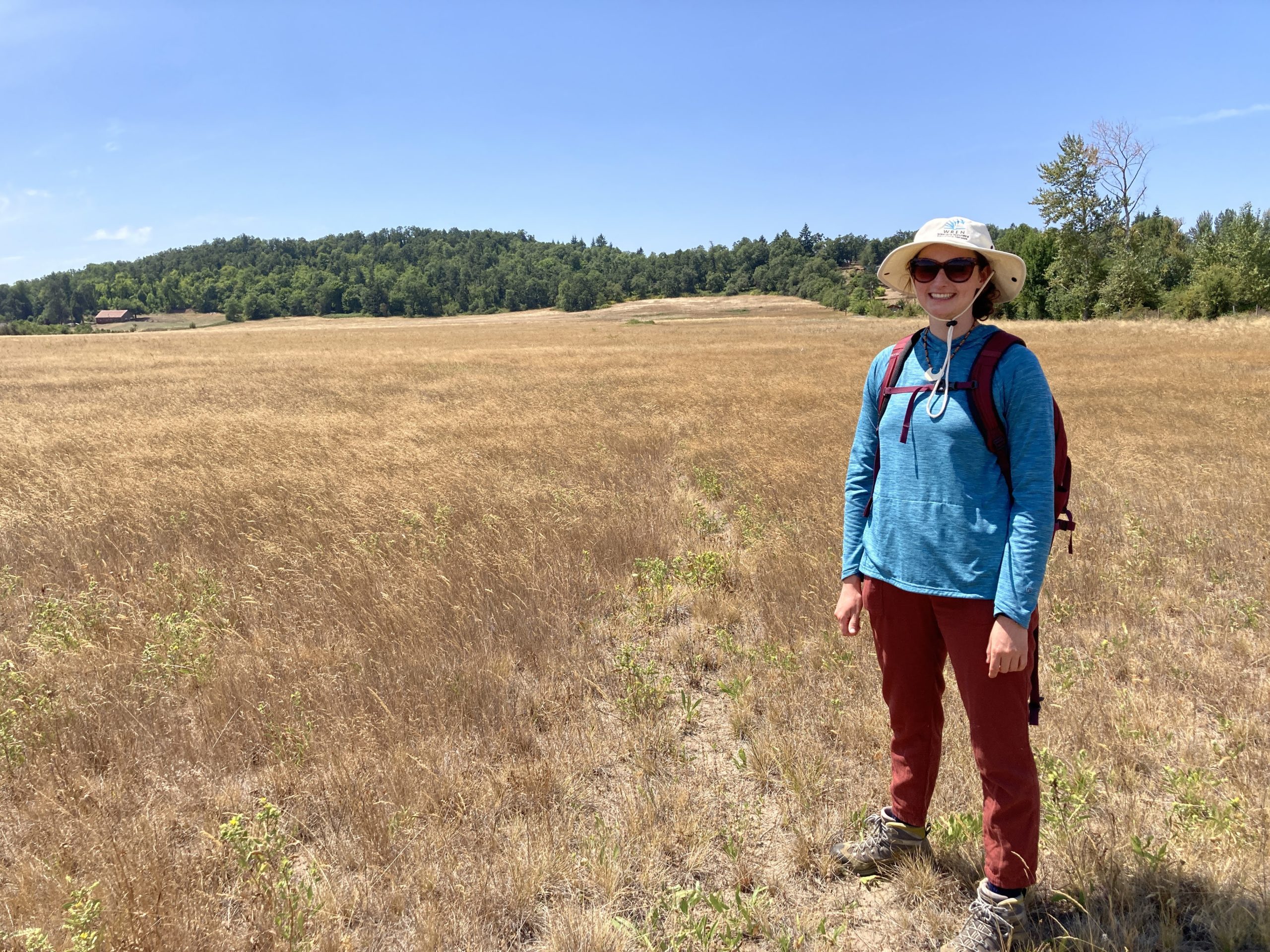The WREN office is located in the West Eugene Wetlands and a large part of our curriculum focuses on wetland ecology. Over the last few months, I have learned about the importance of wetlands: they improve water quality through filtering sediments and pollutants, they act as a natural flood control by storing water after a storm, and they provide habitat for many native plant and animal species. I have surveyed wetland plant species in partnership with the Bureau of Land Management and I have learned to identify native species such as kincaid’s lupine, Willamette daisy, and goldenweed. I have filmed and edited videos taken during wetland walks organized by WREN in addition to teaching environmental education through after school programs and summer camps. Since I am responsible for writing and formatting WREN’s monthly newsletter, I have plenty of pictures and stories to share with you. Here are articles I wrote about my experiences:
Wetlands and Birds
On May 17th, I went on my first nature walk organized by WREN and The Long Tom Watershed Council. We were led through oak woodland, prairie, and wetlands by Rick Ahrens, a local Eugene Naturalist, who captivated our attention through his extensive knowledge of birds. Rick told us that “a family of chickadees might feed 5,000-6,000 caterpillars to their babies in one nesting season.” I was shocked to hear how many caterpillars they eat! Rick went on to say how people planting ‘pest-free’ trees is partly why the song bird population is declining. “There are 3 billion fewer migratory birds than there were 40 years ago,” Rick explained. Native species such as oak trees and wetland grasses are excellent insect habitats that help provide a food source for birds. During our evening walk, we heard Red-Winged Blackbirds calling to each other in the oak trees. This is one species I have learned to identify from its distinctive call. Being new to birding, I liked the tips Rick provided about identifying bird calls. For instance, he likened the Robin to a pop singer with a peppy tune, the Western Tanager to a country singer with a raspy call, and the Black-headed Grosbeak to a belting opera singer. After going on the walk, I am eager to learn more bird calls. Perhaps on my next walk, I will be able to identify some of the species we heard.
Surveying Native Plants in the West Eugene Wetlands
The U.S. Bureau of Land Management (BLM) works to protect and restore wet prairie in the West Eugene Wetlands in partnership with the City of Eugene, The Nature Conservancy, the U.S. Army Corps of Engineers, and the Oregon Youth Conservation Corps. The West Eugene Wetlands Plan, created in 1992, formally acknowledged the importance of wetlands and set forth a plan to protect the unique qualities wetlands possess. Wetlands play a vital role in flood control and storm water purification and are also home to endangered plant and insect species, one of which is the Willamette daisy (Erigeron decumbens).
The Willamette daisy has been a focus in the West Eugene Wetlands for years. Over the past three weeks, I have gone out with surveyors from the BLM to count Willamette daisy populations at one of their restoration sites. Researchers from the Institute for Applied Ecology planted Willamette daisy at this site back in 2000 for a small experimental study to determine the best reintroduction method; plugs or seeds. Luckily, many of the transplants did survive and in 2016, the BLM planted more Willamette daisies. Since then, three more plantings have taken place at this site in the years 2017, 2018, and 2021. The BLM monitors Willamette daisy populations annually to see if the plants have grown and to learn how many transplants survived. Through this work, it is hopeful that Willamette daisy may one day be taken off the endangered species list. Currently, the Willamette daisy is both federally and state recognized as endangered. Since 2018, the BLM has planted over 11,000 Willamette daisy plants in the West Eugene Wetlands. The BLM manages 1,340 acres of land within the West Eugene Wetlands and conducts conservation work at many of its sites.
Past BLM conservation work has proven effective. The once endangered Bradshaw’s Lomtium (Lomatium bradshawii) was able to be delisted in part thanks to the BLM work in the West Eugene Wetlands. By participating in the Willamette daisy monitoring this year, I have seen the thoroughness and care of the BLM surveyors while out in the field. I am proud to contribute my time to a meaningful project that works to restore native species in the wetlands. The BLM of the West Eugene Wetlands has worked for years to enhance and protect our local wetlands and will continue to do so for years to come.
Willamette River Festival Natural Dye Art Installations
This year for the Willamette River Festival, Lane Arts Council and WREN have partnered together to lead summer camps that focus on the importance of protecting our rivers. The summer camps are underway! From July through August there are a total of five summer camps that include the following organizations: Boys & Girls Club of Emerald Valley, Willamalane, Invention Day Camp with Connected Lane County, and Fern Ridge School District. Throughout the one-week long camp, elementary and middle school students learn how to create natural dye and use it to dye fiber for public art installations that will be on display through established self-guided tour routes during the Willamette River Festival. Alex Ever, from Lane Arts Council, has a passion for natural dyes and teaches students how to make dyes from materials such as hibiscus petals, instant coffee, herbal and black tea blends, turmeric, beet powder, and even White oak galls that can be found in our local wetlands, to name a few. Some camps are making banners to be hung from trees while other camps are making dyed fiber art to be displayed on a floating platform. Students learn how natural dyes are safer for the river and how it is up to us to keep the water clean.
That’s where WREN’s Environmental Education Specialist, Ellen Thompson, comes in. Ellen has been assisting with these summer camps enhancing Alex’s art teaching with water pollution education. Ellen gets the students thinking about what human activities pollute the water. After students discuss what they see on The Many Uses of Water poster developed by the City of Eugene’s stormwater program, they are able to identify what activities pollute the water and some action steps to preventing pollution. Students learn that the mainstem of the Willamette runs 187 miles until it meets the Columbia River. By looking at a map of the river, they are able to identify where the headwaters of the Willamette start in the Eugene/Springfield area and how the river flows north through Corvallis, Albany, Salem, and Portland. After the lesson, they reach a better understanding that pollution we put in the water will go to our northern neighbors and eventually out into the Pacific Ocean. One of the key source waters of the Willamette system is Waldo Lake, one of the purest lakes in the world, in contrast to the highly polluted Superfund site located at the confluence of the Columbia River. Students are shocked to learn that waters that start so clean can become so unhealthy.
The students learn how natural dye and river water are connected in a very tangible way. The Eugene/Springfield area gets its tap water from the McKenzie River. The McKenzie River is a tributary of the Willamette, meaning a smaller river that flows into the Willamette River. To make natural dye, the students must boil tap water and the dye ingredient together. The water the students use to make the dye comes from the river itself. This fact really resonates with the students. It drives home that fact how important the river is and how we rely on the river every day.
If you are interested in learning about the water quality of the Willamette River or any other water body in our area, visit How’s My Waterway? a website set up by the Environmental Protection Agency to inform you about the health of water bodies in your area.


